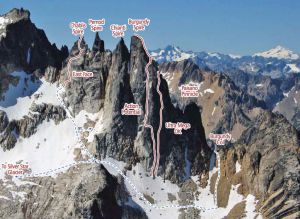East Face, Chablis Spire II 5.6R |
||
Washington Pass, Washington, USA | ||
| ||
|
Avg time to climb route: 1-3 hours
Approach time: 3-5 hours Descent time: 3-5 hours Number of pitches: 4 Height of route: 400' Overview
The East Face is an unknown classic. It features good rock and moderate climbing among spires known for their difficulty. The one intimidating section, the short 5.6 R stretch on Pitch 2, is more like 5.4 or 5.5 and climbs big holds on clean rock. It is easier than the 5.6 R on the “Nervous Nelly pitch” on the Southwest Rib of South Early Winters Spire. While the route wanders back and forth, it has large, comfortable belay ledges and is sustained with every pitch at 5.6 (a rarity). This route is for solid 5.6 or 5.7 climbers.Photos
- View all 2 photos of East Face as: Thumbnails | Slideshow
Climber Beta on East Face
Find other routes like
East Face
Route History
The route was climbed by Fred Beckey, Richard Berge and Wesley Grand on June 17, 1952. Beckey, Berge and Grand had hiked in with the intent of climbing as many of the spires as possible. At first, the Wine Spires appeared impregnable, with enormous 1,200-foot west faces, and eastern faces rising 400-800 feet.Berge spied a line on the granite slabs below Chablis spire. According to Beckey, “Although the route seemed to verge on the impossible, it turned out to be a delightful belayed climb, and we only had to use two pitons.” The trio was pleased that they had discovered a fun route on very solid rock. After reaching the slender summit of Chablis, they descended and traversed to the lower flanks of Pernod Spire. They crossed a ledge along the east face and gained a notch on the north side of the peak between Chianti and Pernod Spires. They looked for a possible route, struggled with a slab for two hours, and placed two bolts and several pitons. With more difficult ground above them, they realized that the climb would likely take more gear and a full day to complete. Not prepared to bivi on the wall, they rappelled to the glacier. Later in the summer, Beckey and Wilde returned with McGowan, Hieb and Maki to the Wine Spires and camped in the upper Silver Star Creek. With a pre-dawn start, Beckey, Wilde and McGowan retraced their earlier attempt on Pernnod spire. Hieb and Maki went to attempt Chianti, planning to rappel 250 feet down from the notch and attempt a route on the other side. Beckey, McGowan, and Wilde regained the previous high point at the bolts. Sustained and difficult climbing brought them to the summit. While they had been skeptical about the other team’s odds on Chianti, they could see them, also on the summit of Chianti, less than 50 feet away. Strategy
The approach is long and the final permanent snowfield is steep (35-40 degrees) which deters crowds. Bring crampons and an ice axe. On the approach, look for the large, obviously split, detached block. The route starts just left.The route steps off the permanent snowfield and ascends a very clean and fun right-trending 5.6 handrail flake. Above is a 5.8 variation chimney that has less rope drag but is much harder. The easier option is to make an exposed step down (protect your second) and traverse along the large detached block. The easiest way is to go all the way right and climb up an easy 5th class gully-chimney-thing to another ledge and the top of Pitch 1. You pass a splitter 5.8 finger crack that is awesome (watch the rope drag before starting up this crack). Pitch 2 is moderate and fun to another small ledge below a well-featured slab. Don’t go left. Instead, climb this fun, clean, and secure but protection-less section to another ledge (soft 5.6 R). There are many excellent hand and footholds. Rests are abundant and the climbing is straightforward. However, falling on this section would be bad. Climb more 4th and low 5th class up a ramp system to the belay. Above here, the route finding gets a little more devious. Climb up and right on easy rock to a corner with a short, well-protected chimney. You’ll be tempted to set up a belay on this ledge, but there isn’t very good gear for the belay, so continue to climb up and right another 25 feet to a higher ledge and belay off a bomber horn. This pitch is long, at 170 feet. Above here, don’t go straight up. It looks easier, but the rock and the protection are poor. Instead, cross the ledge and climb up a fun, well-protected, but a little lichen-covered 5.6 corner until it eases and ends on a ledge just 15 feet below the summit. Climbers typically visit the tiny summit one at a time, leaving the gear in place for each climber to lead up the final 15 feet separately, and then do a belayed down climb. The last climber removes the gear. Retreat Storm
The rap route more or less follows the ascent route and you could bail at any point using two ropes. If you only had one rope, you could easily make it down but having some webbing and cordage to tie around horns and blocks would be a must. The granite is pretty clean and this face gets a fair bit of morning sun, so this route dries out relatively quickly after a storm.
Everything You Need to Know About
Washington Pass
Search the internet for beta on
East Face
|
|


